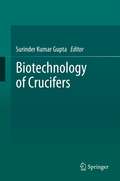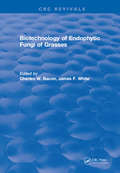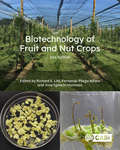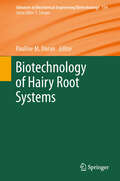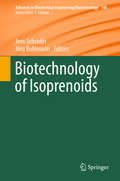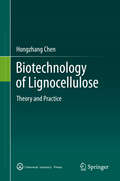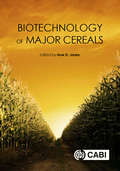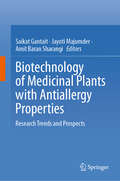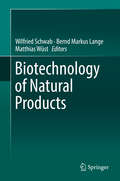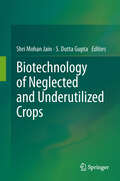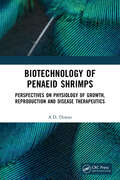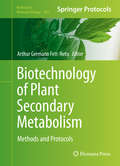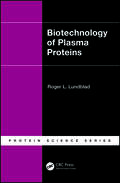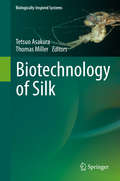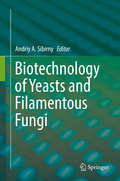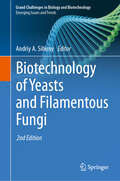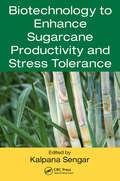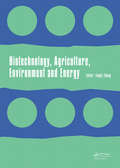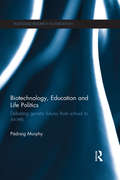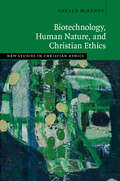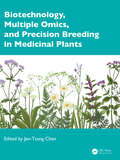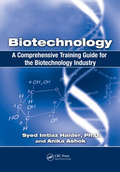- Table View
- List View
Biotechnology of Crucifers
by Surinder Kumar GuptaDespite the recent advances made in the improvement of crucifer crops using conventional breeding techniques, the yield levels and the oil and meal quality could not be improved as expected. The understanding of genetic material (DNA/RNA) and its manipulation by scientists has provided the opportunity to improve crucifers by increasing its diversity beyond conventional genetic limitations. The application of the biotechnological techniques will have major impacts in two ways: first, it provides a number of techniques/methods for efficient selection for favorable variants and second, it gives an opportunity to utilize alien variation available in the crucifers by using the novel techniques of biotechnology to develop high yielding varieties with good nutritional quality, having resistance to insect, pest, and disease resistance.
Biotechnology of Endophytic Fungi of Grasses
by Charles W. BaconThis book considered the biological, ecological, toxicology, and chemical aspects of research topics as they relate to endophytes of grasses. Several chapters reflect the very pragmatic applications of endophytes and endophyte-infected grasses. Other chapters offer future applications for endophytes and are therefore discussed from theoretical viewpoints. This book contains the collective writings of an international group of experts on fungal endophytes of grasses, all of whom are directed toward, understanding, creating, and exploiting the positive aspects of endophytes. With this book, we are attempting to stimulate and facilitate future explorations of the grass endophytes.
Biotechnology of Extremophiles: Advances and Challenges (Grand Challenges in Biology and Biotechnology #1)
by Pabulo H. RampelottoAimed at research scientists and biotechnologists, this book is an essential reading for those working with extremophiles and their potential biotechnological application. Here, we provide a comprehensive and reliable source of information on the recent advances and challenges in different aspects of the theme. Written in an accessible language, the book is also a recommended as reference text for anyone interested in this thriving field of research. Over the last decades, the study of extremophiles has provided ground breaking discoveries that challenge our understanding of biochemistry and molecular biology. In the applied side, extremophiles and their enzymes have spawned a multibillion dollar biotechnology industry, with applications spanning biomedical, pharmaceutical, industrial, environmental, and agricultural sectors. Taq DNA polymerase (which was isolated from Thermus aquaticus from a geothermal spring in Yellowstone National Park) is the most well-known example of the potential biotechnological application of extremophiles and their biomolecules. Indeed, the application of extremophiles and their biologically active compounds has opened a new era in biotechnology. However, despite the latest advances, we are just in the beginning of exploring the biotechnological potentials of extremophiles.
Biotechnology of Fruit and Nut Crops
by Maria Luisa Badenes Patrick Brown Nicolas Roux Araceli Barceló-Muñoz Vicente Vicente Óscar Martínez Eddo Rugini Luciana Baldoni Alain Rival Magda-Viola Hanke Henryk Flachowsky Julie Graham Luis A. Cañas Dennis J. Gray Stephen Adkins J. R. Botella Leandro Pena Ossama Kodad Pedro Martínez-Gómez Abhaya Dandekar Sadanand A. Dhekney Yuval Cohen Kate Evans Nuria Alburquerque Pedro M. Barros A. T. Basford Muhammad Ajmal Bashir Diego Silva Batista Dr Julianne Biddle Manuel Blasco Lorenzo Burgos John E. Carlson Elisabeth Carmona David Chagné Rekha Chaudhury Elisabeth Chevreau V. E. Chhatre Yelda Özden Çiftçi C. Claflin Elena Corredoira Valerio Cristofori Niccolò Cultrera Maurecilne Lemes da Silva Leo D’Souza Ofere Francis Emeriewen M. Faize Fábio Gelape Faleiro Ana Paula Farinha Yolanda Ferradás Antonio Figueira Maureen M.M. Fitch M. Foale Svetlana Y. Folimonova María Victoria González Isabel María González-Padilla Smitha Hegde Professor Jose Ignacio Hormaza Uma Jaiswal Nikki Jennings Hülya Akdemir Koç Nerea Larrañaga Chuck Leslie Z. J. Li Amanda De Lopes Carlos López-Encina Rodolfo López-Gómez Jorge Lora Zheng-Rong Luo S. K. Malik Roberto Mariotti Antonio J. Matas José Mercado Scott Merkle Sara Montanari Gloria Moore Soraya Mousavi Isabel Narváez María Del Naval Q. T. Nguyen Shashikiran Nivas M. Margarida Oliveira Ahmet Onay Guillermo Padilla Elena Palomo-Ríos Andreas Peil Rosa M. Pérez-Clemente Cesar Petri Paula M. Pijut Marcos Vinícius Pinheiro Clara Pliego Fernando Pliego-Alfaro Simon H.T. Raharjo Manoj K Rai Manuel Rey Gabino Ríos Diego Ismael Rocha M. B. Rosenberg M. Rouard D. Ruiz J. Sardos Danielle Camargo Scotton Cristian Silvestri Michael K Smith Guo-Qing Song Veysel Süzerer Alicia Talavera Ryutaro Tao Takuya Tetsumura Engin Tilkat Pablo Ric Varas Wagner Vendrame Francisco Javier Viéitez Hazel Wetzstein Roxana Yockteng Qing-Lin ZhangThis book covers the biotechnology of all the major perennial fruit and nut species. Since the publication of the first edition of this book in 2005, there has been significant progress in cell culture, genomics and genetic transformation for many of these species. This book covers these biotechnologies and also traditional ones, such as regeneration pathways, protoplast culture, in vitro mutagenesis, and ploidy manipulation that have been applied to many of these species. Three species, Diospyros kaki (persimmon), Punica granatum (pomegranate) and Eriobotrya japonica (loquat) are included for the first time, and several Prunus species now receive separate coverage. The species are organized by plant family to facilitate comparisons among related ones. Each species is discussed in relation to its family and its related wild forms, and most are accompanied by full colour illustrations. This book is a vital resource for those working on the improvement of perennial fruit, nut and plantation crops. The book features: Detailed coverage of major perennial fruit and crop species. Coverage of traditional and new biotechnologies. Full colour illustrations to aid identification This book is an essential resource for scientists and postgraduate students who are engaged in the improvement of perennial fruit, nut and plantation crops and will also be an important accession for university and agricultural research libraries.
Biotechnology of Hairy Root Systems (Advances in Biochemical Engineering/Biotechnology #1192)
by Pauline M. DoranVictor P. Bulgakov, Yuri N. Shkryl, Galina N. Veremeichik, Tatiana Y. Gorpenchenko and Yuliya V. Vereshchagina: Recent Advances in the Understanding of Agrobacterium rhizogenes-Derived Genes and Their Effects on Stress Resistance and Plant Metabolism. Le Zhao, Guy W. Sander and Jacqueline V. Shanks: Perspectives of the Metabolic Engineering of Terpenoid Indole Alkaloids in Catharanthus roseus Hairy Roots. Jian Wen Wang and Jian Yong Wu: Effective Elicitors and Process Strategies for Enhancement of Secondary Metabolite Production in Hairy Root Cultures. Amanda R. Stiles and Chun-Zhao Liu: Hairy Root Culture: Bioreactor Design and Process Intensification. Marina Skarjinskaia, Karen Ruby, Adriana Araujo, Karina Taylor, Vengadesan Gopalasamy-Raju, Konstantin Musiychuk, Jessica A. Chichester, Gene A. Palmer, Patricia de la Rosa, Vadim Mett, Natalia Ugulava,Stephen J. Streatfield and Vidadi Yusibov: Hairy Roots as a Vaccine Productionand Delivery System. Zahwa Al-Shalabi and Pauline M. Doran: Metal Uptake and Nanoparticle Synthesis in Hairy Root Cultures.
Biotechnology of Isoprenoids (Advances in Biochemical Engineering/Biotechnology #149)
by Jens Schrader Jörg BohlmannThis book review series presents current trends in modern biotechnology. The aim is to cover all aspects of this interdisciplinary technology where knowledge, methods and expertise are required from chemistry, biochemistry, microbiology, genetics, chemical engineering and computer science. Volumes are organized topically and provide a comprehensive discussion of developments in the respective field over the past 3-5 years. The series also discusses new discoveries and applications. Special volumes are dedicated to selected topics which focus on new biotechnological products and new processes for their synthesis and purification. In general, special volumes are edited by well-known guest editors. The series editor and publisher will however always be pleased to receive suggestions and supplementary information. Manuscripts are accepted in English.
Biotechnology of Lignocellulose: Theory and Practice
by Hongzhang ChenThis book presents and summarizes the new thoughts, new methods and new achievements that have emerged in the biotechnology of lignocellulose in recent years. It proposes new concepts including the primary refining, fractionation, multi-level utilization and selective structural separation of lignocellulose, etc. By approaching lignocellulose as a multi-level resource, biotechnology could have a significant effect on ecological agriculture, bio-energy, the chemical and paper making industries, etc. , ultimately establishing distinctive eco-industrial parks for lignocellulose. Additionally, this book provides systematic research methods for the biotechnology of lignocellulose including investigation methods for the primary refining of lignocellulose, for microbial degradation and enzymatic hydrolysis, for cellulose fermentation and for lignocellulose conversion processes. It offers an excellent reference work and guide for scientists engaging in research on lignocellulose. Dr. Hongzhang Chen is a Professor at the Institute of Process Engineering of the Chinese Academy of Sciences, Beijing, China.
Biotechnology of Major Cereals
by Li Zhu Wendy Wendy Ning Zhou Jeffrey Beringer James Bing Chen Wei Tristan Coram Tanya Curtis Jim Jim Sylvester Elikana Anami Gabor Gabor Nigel Nigel Hai-Chun Jing Balázs Kalapos Cuma Karaoglu Anca Macovei Hilde-Gunn Hilde-Gunn Kaitlin Pidgeon Ayten Salantur Parwez Samnakay Inez Slamet-Loedin Alexandra Soltész Caroline Sparks Nicholas Storer Yong-Wei Sun Kerry Swartwood Attila Vágújfalvi Joyce Joyce Gen-Ping Wang Huixia Wu Lan-Qin Xia Xiu-Dao Yu Li-Xin Zhang Yu-Miao ZhangBiotechnology of Major Cereals focuses on the recent advances and future prospects in cereal biotechnology. The first part of the book covers the world's major cereals and focus on new developments and trends. The second part is technology rather than species-led, detailing fundamental developments in technologies and significant target traits.
Biotechnology of Major Cereals
by Huw D. JonesBiotechnology of Major Cereals will focus on the recent advances and future prospects in cereal biotechnology. The first part of the book will cover the world's major cereals and focus on new developments and trends. The second part will be technology rather than species-led, detailing fundamental developments in technologies and significant target traits.
Biotechnology of Medicinal Plants with Antiallergy Properties: Research Trends and Prospects
by Amit Baran Sharangi Saikat Gantait Jayoti MajumderThis book comprehensively covers critically investigated information on medicinal plants prioritized for their anti-allergy properties. It offers insights into strategies related to the distribution, mechanism of action, and assessment of antiallergic medicinal plants, and also delves into crucial aspects of modern biotechnological tools, addressing their implementation challenges, presenting innovative approaches through case studies, and exploring opportunities for nanotechnologies. These elaborated discussions aim to raise awareness and bridge the gap between human health and the biodiversity of antiallergic medicinal plants. As the book navigates the uncertainties of plant-based medicines in the post-COVID-19 era, it provides real-world applications showcasing the specific utility of medicinal plants through advanced biotechnological insights. This book covers several medicinal plants associated with antiallergy, exploring their modes of action, available secondary metabolites,and estimation methods. It also emphasizes all modern biotechnological interventions aimed at propagating, multiplying, and conserving this unique treasure trove of medicinal plants. The World Health Organization estimated that 80% of the populations of developing countries rely on traditional medicines, mostly plant drugs, for their primary health care needs. Increasing demand in both developing and developed countries resulted in the expanding trade of medicinal plants and has serious implications for the survival of several plant species, with many under threat of becoming extinct. This book describes various approaches to conserving these genetic resources. It discusses the whole spectrum of biotechnological tools from micro-propagation for large-scale multiplication and cell-culture techniques to the biosynthesis and enhancement of pharmaceutical compounds in plants. It also discusses the genetic transformation as well as short- to long-term conservation of plant genetic resources via synthetic seed production and cryopreservation, respectively. This reference book is useful for researchers in the pharmaceutical and biotechnological industries, medicinal chemists, biochemists, botanists, molecular biologists, academicians, students as well as allergic patients, traditional medicine practitioners, scientists in medicinal and aromatic plants, and other traditional medical practitioners.
Biotechnology of Natural Products
by Wilfried Schwab Bernd Markus Lange Matthias WüstThis text comprehensively covers the analysis, enzymology, physiology and genetics of valuable natural products used in the food industry that are attractive targets for biotechnological production. The focus is on the recent advances made to achieve this goal. This unique work is the first book to focus on biotechnological production of important natural products in food additives, fragrances and flavorings, vitamins and other bioactive compounds in food. The chapters offer a deep insight into modern research and the development of low molecular weight natural products. Biotechnology of Natural Products covers products in the Phenolic, Terpenoid, Vitamin and Alkaloid categories, providing a full overview of the biotechnology of food additives and other low molecular weight natural products. Gene clustering and the evolution of pathways are covered, as well as future perspectives on the topic. Due to limited oil resources and increasing consumer demand for naturalness, bioprocesses are increasingly needed to meet these requirements. Novel sophisticated technologies have facilitated the elucidation of new chemical molecules, their biosynthetic pathways and biological functions. This book provides researchers with a full overview of the technologies and processes involved in the biotechnology of natural products.
Biotechnology of Neglected and Underutilized Crops
by Shri Mohan Jain S. Dutta GuptaThis important reference is the first comprehensive resource worldwide that reflects research achievements in neglected and underutilized crop biotechnology, documenting research events during the last three decades, current status, and future outlook. This book has 16 chapters divided into 4 sections. Section 1 has three chapters dealing with Chenopodium as a potential food source, thin cell layer technology in micropropagation of Jatropha, and Panax vietnamensis. Section 2 deals with molecular biology and physiology of Haberlea rhodopensis, cell trait prediction in vitro and in vivo of legumes, and application of TILLING in orphan crops. Section 3 has five chapters on biotechnology of neglected oil crops, Quinoa, Erucia sativa, Stylosanthes, and Miscanthus. And Section 4 contains five chapters mainly on genetic transformation of Safflower, Jatropha, Bael, and Taro. This section also includes a chapter on genetic engineering of Mangroves.
Biotechnology of Penaeid Shrimps: Perspectives on Physiology of Growth, Reproduction and Disease Therapeutics
by A.D. DiwanThe main objective of this book is to collect comprehensive information on various aspects of physiology and biotechnology focusing mainly on reproduction, growth, disease control and therapeutics of penaeid shrimps. The book covers fundamental aspects and few applied aspects of biotechnology concerning basic genomics and proteomics, reproduction, growth and disease control and therapeutics of shrimp. This information will be quite useful not only to the aqua-farmers/mariculture experts of the shrimp industry to augment quality shrimp production in captive condition but also to the faculties and students working in different organizations involved in teaching and research activities in shrimp biotechnology.Note: T&F does not sell or distribute the Hardback in India, Pakistan, Nepal, Bhutan, Bangladesh and Sri Lanka.
Biotechnology of Plant Secondary Metabolism: Methods and Protocols (Methods in Molecular Biology #1405)
by Arthur Germano Fett-NetoThis volume describes up-to-date techniques for improved production of secondary metabolites of economic interest using field and laboratory methods. Biotechnology of Plant Secondary Metabolism: Methods and Protocols explores different secondary metabolite classes, whole-plant and cell/organ culture systems, and environmental and genetic transformation-based modulation of biochemical pathways. Special focus is given to cell and tissue specific metabolism, metabolite transport, microRNA-based technology, heterologous systems expression of enzymes and pathways leading to products of interest, as well as applications using both model and non-model plant species. Written in the highly successful Methods in Molecular Biology series format, chapters include introductions to their respective topics, lists of the necessary materials and reagents, step-by-step, readily reproducible laboratory protocols, and tips on troubleshooting and avoiding known pitfalls. Practical and cutting-edge, Biotechnology of Plant Secondary Metabolism: Methods and Protocols is a great resource for scientists of interdisciplinary fields--plant science, plant physiology, pharmacy, molecular biology, biochemistry, bioengineering, and forestry--in reaching their goals of producing plant biochemicals in a sustainable and efficient manner, while minimizing impacts to the environment and providing the required quantities of these commodities to industry.
Biotechnology of Plasma Proteins (Protein Science)
by Roger L. LundbladThe fractionation of human blood plasma can be considered to be a mature industry, with the basic technology, alcohol fractionation, dating back at least to the 1940s. Many of the products described in the current work have been approved biologics since the 1950s. The information gathered from the development of plasma proteins has proved vital to
Biotechnology of Silk (Biologically-Inspired Systems #5)
by Tetsuo Asakura Thomas MillerThis book is a snapshot of the current state of the art of research and development on the properties and characteristics of silk and their use in medicine and industry. The field encompasses backyard silk production from ancient time to industrial methods in the modern era and includes an example of efforts to maintain silk production on Madagascar. Once revered as worth its weight in gold, silk has captured the imagination from its mythical origins onwards. The latest methods in molecular biology have opened new descriptions of the underlying properties of silk. Advances in technological innovation have created silk production by microbes as the latest breakthrough in the saga of silk research and development. The application of silk to biomaterials is now very active on the basis of excellent properties of silks including recombinant silks for biomaterials and the accumulated structural information.
Biotechnology of Yeasts and Filamentous Fungi
by Andriy A. SibirnyThis book provides a comprehensive overview on biotechnological applications of unicellular and multicellular fungi in a variety of industrial branches. Targeted genetic and metabolic engineering of fungi allows production of native and transgenic enzymes and proteins in industrial scales. Those most prominently find application in biorefineries for the production of value-added chemicals and biofuels, in the pharmaceutical industry as well as in biomedicine. Each chapter is dedicated to applications and potential beneficial use of particular strains of yeasts and filamentous fungi and their produced biomolecules. The book targets researchers from both academia and industry and graduate students working in microbial biotechnology.
Biotechnology of Yeasts and Filamentous Fungi (Grand Challenges in Biology and Biotechnology)
by Andriy A. SibirnyThis updated and extended second edition provides a comprehensive overview on biotechnological applications of unicellular and multicellular fungi in a variety of industrial settings. Each chapter is dedicated to applications and potential beneficial use of particular strains of yeasts and filamentous fungi and their produced biomolecules, ranging from glycerol to carotenoids. This new edition further includes a brand-new chapter on lactic acid production in yeast. Targeted genetic and metabolic engineering of fungi allows production of native and transgenic enzymes and proteins in industrial scales. Those most prominently find application in biorefineries for the production of value-added chemicals and biofuels, in the pharmaceutical industry as well as in biomedicine. This volume addresses researchers from both academia and industry, and graduate students working in microbial biotechnology.
Biotechnology to Enhance Sugarcane Productivity and Stress Tolerance
by Kalpana SengarSugarcane is the most important plant source for sugar and alcohol production and is cultivated in more than 80 countries in tropical and subtropical areas. However, environmental factors negatively influence its yield and jeopardize the prospect to meet the increasing demand for sugar, other sugarcane derived by products and bioethanol. The development of stress tolerant plants is fundamental for the maintenance and increase of crop yields. Biotechnology to Enhance Sugarcane Productivity and Stress Tolerance provides a comprehensive account of both theoretical and practical aspects of sugarcane production. It contains extensive coverage of genome mapping and molecular breeding in sugarcane and presents the status of the elucidation and improvement of plant genomes of economic interest. Through 14 chapters written by eminent scientists with global influence, this book examines various methods for sugarcane improvement through biotechnology. The book focuses on genetic and physical mapping, positioning, cloning, and monitoring of desirable genes using biotechnological approaches for high sugarcane productivity and the development of stress tolerance. Additional information includes the bioengineering of sugarcane, procedures to boost productivity, genetics and assessments for resistance to drought and salinity, genetics for high yields, and various topics of research on sugarcane genetics. It serves as a detailed reference source for cane growers, sugar and sugarcane technologists, students, and professors.
Biotechnology, Agriculture, Environment and Energy: Proceedings of the 2014 International Conference on Biotechnology, Agriculture, Environment and Energy (ICBAEE 2014), May 22-23, 2014, Beijing, China.
by Fangli ZhengThe 2014 International Conference on Biotechnology, Agriculture, Environment and Energy (ICBAEE 2014) was held May 22-23, 2014 in Beijing, China. The objective of ICBAEE 2014 was to provide a platform for researchers, engineers, academics as well as industry professionals from all over the world to present their research results and development act
Biotechnology, Education and Life Politics: Debating genetic futures from school to society (Routledge Research in Education)
by Pádraig MurphyWhat should individuals and society do when genetic screening becomes widely available and with its impact on current and future generations still uncertain? How can our education systems around the world respond to these developments? Reproductive and genetic technologies (RGTs) are increasingly controversial and political. We are entering an era where we can design future humans, firstly, by genetic screening of "undesirable" traits or indeed embryos, but perhaps later by more radical genetic engineering. This has a profound effect on what we see as normal, acceptable and responsible. This book argues that these urgent and biopolitical issues should be central to how biology is taught as a subject. Debate about life itself has always been at the forefront of connected molecular, genetic and social/personal identity levels, and each of these levels requires processes of communication and debate, what Anthony Giddens called in passing life politics. In this book Pádraig Murphy opens the term up, with examples from field research in schools, student responses to educational films exploring the future of RGTs, and science studies of strategic biotechnology and the lab practices of genetic screening. Life political debate is thoroughly examined and is identified as a way of connecting mainstream education of biology with future generations. Biotechnology, Education and Life Politics will appeal to post-graduates and academics involved with science education, science communication, communication studies and the sociology of education.
Biotechnology, Human Nature, and Christian Ethics (New Studies in Christian Ethics)
by Gerald McKennyIn public debates over biotechnology, theologians, philosophers, and political theorists have proposed that biotechnology could have significant implications for human nature. They argue that ethical evaluations of biotechnologies that might affect human nature must take these implications into account. In this book, Gerald McKenny examines these important yet controversial arguments, which have in turn been criticized by many moral philosophers and professional bioethicists. He argues that Christian ethics is, in principle, committed to some version of the claim that human nature has normative status in relation to biotechnology. Showing how both criticisms and defences of this claim have often been facile, he identifies, develops, and critically evaluates three versions of the claim, and contributes a fourth, distinctively Christian version to the debate. Focusing on Christian ethics in conversation with secular ethics, McKenny's book is the first thorough analysis of a controversial contemporary issue.
Biotechnology, Multiple Omics, and Precision Breeding in Medicinal Plants
by Jen-Tsung ChenBiotechnology, Multiple Omics, and Precision Breeding in Medicinal Plants explores the various methods for advancing medicinal plant research. It covers a wide range of approaches, including integrated and advanced plant biotechnology, mutagenesis, nanotechnology, genome-wide association studies, multiple omics tools, and high-throughput technologies. The book highlights the significant impact of combining pan-genomics with metabolomics in medicinal plant research, particularly in understanding how genetic diversity influences the profiles of secondary metabolites and the therapeutic potential of these plants.FEATURES: Explores ways to improve the production of secondary metabolites and bioactive compounds in key medicinal plants Features information on bioinformatics, artificial intelligence models, molecular markers, and genome editing techniques such as CRISPR-assisted precision breeding Promotes specific prebiotic formulas to ward off adverse effects of antibiotics Covers information on epigenetic regulation in boosting secondary metabolite production and the use of speed breeding combined with high-throughput technologies Proposing a multitude of technologies and methodologies in plant biotechnology with focus on enhancing the production of secondary metabolites and bioactive compounds from medicinal plants, this book is an ideal resource for researchers and academia in plant sciences/breeding, agriculture, and horticulture industries.
Biotechnology: A Comprehensive Training Guide for the Biotechnology Industry
by Syed Imtiaz Haider Anika AshtokAll manufacturing companies face the daunting task of designing an employee training matrix that meets the gamut of national and international regulatory standards. Answering the call for a one-stop training resource that focuses exclusively on this multi-faceted, high-tech industry, Biotechnology: A Comprehensive Training Guide for the Biotechnology Industry provides ready-to-implement training templates that save time and expense without cutting corners on critical elements.Downloadable Resources: Why Reinvent the Wheel?This complete, single-source reference contains 28 complete biotechnology courses and a customizable downloadable resources with hands-on training tools. The book also provides time-saving information on how to orient employees involved in writing and executing batch manufacturing and in-process control documents.Key Benefits: Contains adaptable training text, test summaries and papers, test answers, and certificates of completion Streamlines the training process, maximizing efficiency Boosts the marketing edge over competitors This valuable training tool presents step-by-step guidance for optimizing research and development expenditures, avoiding marketing delays, gaining a competitive advantage, reducing product development failures, developing skilled manpower, and maintaining local and international regulatory compliance.
Biotechnology: A Laboratory Skills Course
by J. Kirk BrownA general survey of knowledge and techniques needed to function in a biotechnology lab.
